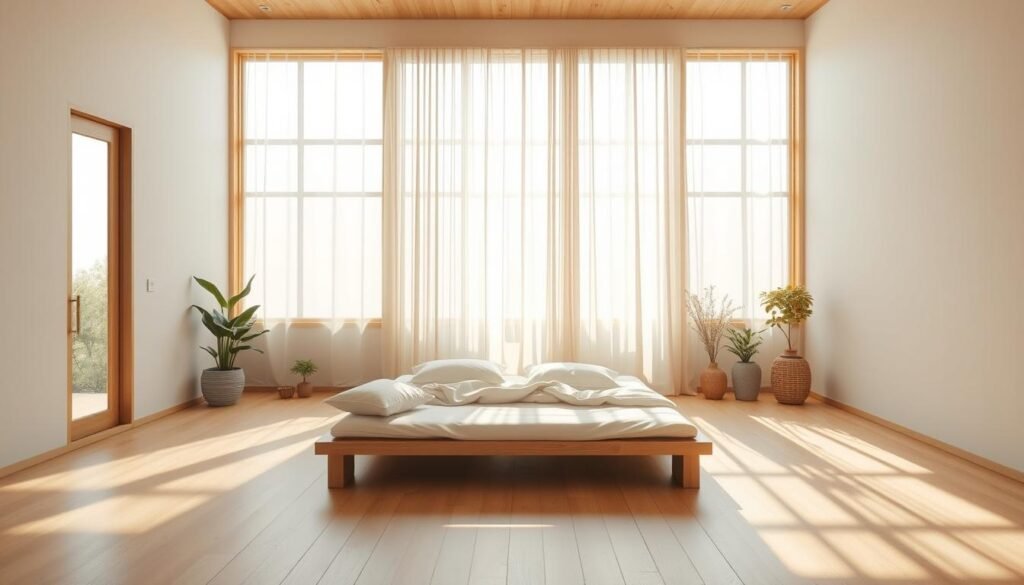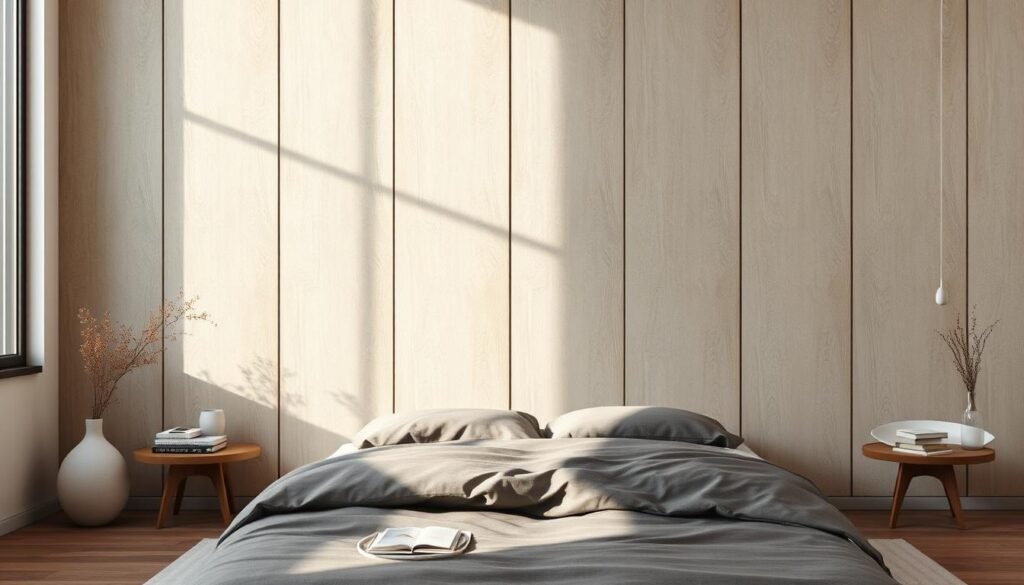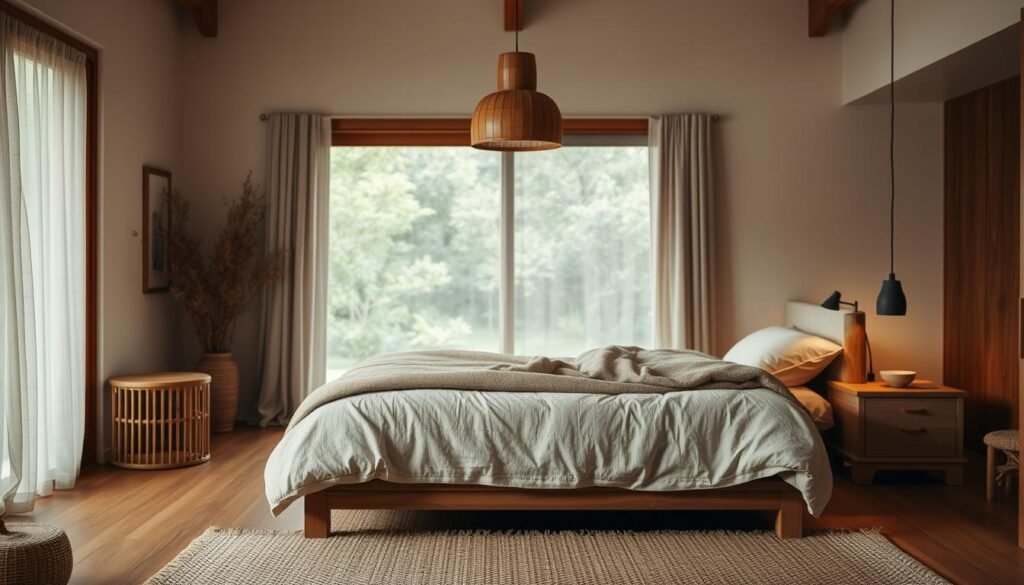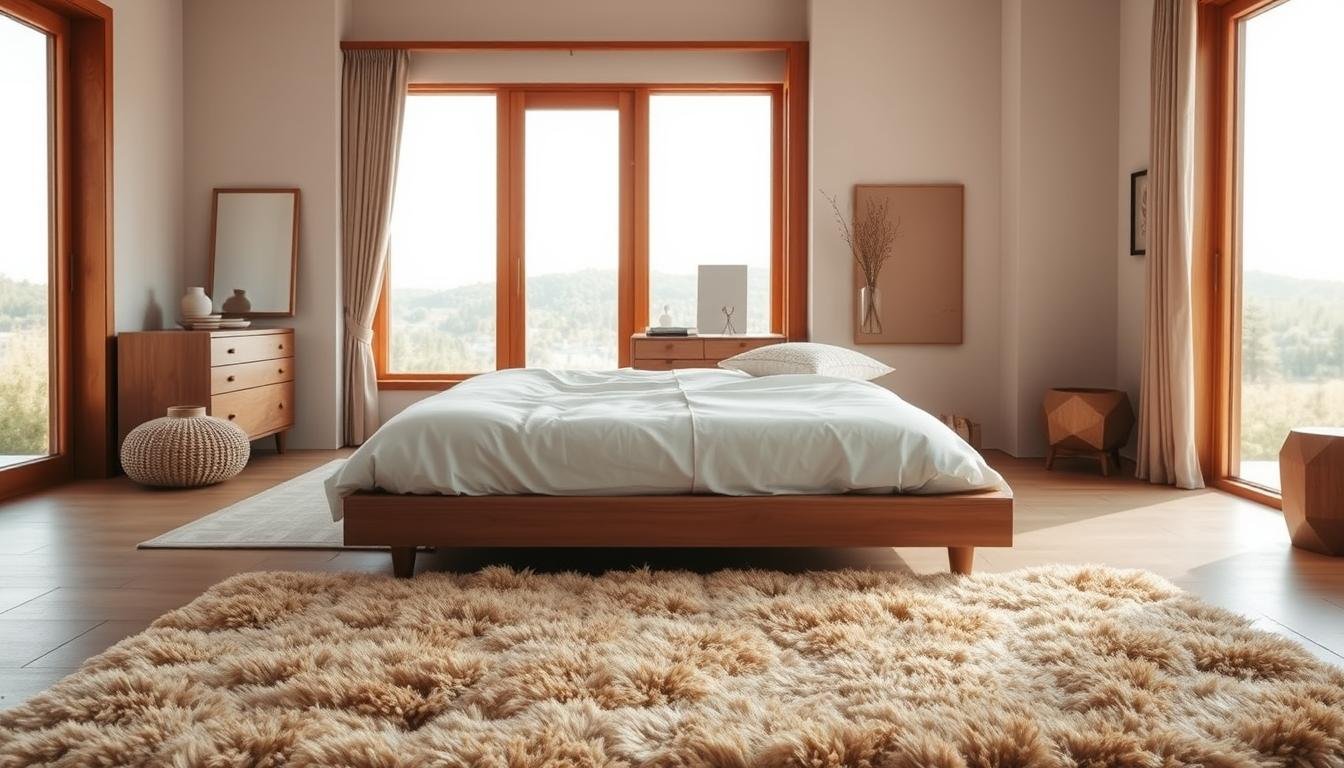This post may contain affiliate links. When you purchase through links on our site, we may earn an affiliate commission.
Last winter, I found myself staring at my cluttered, mismatched room, feeling overwhelmed. I craved a space that felt calm yet inviting—a retreat from the chaos of daily life. That’s when I stumbled upon Japandi design, a blend of Japanese minimalism and Scandinavian warmth. Inspired by Truss Interiors’ clean layouts and Julee Wray’s focus on organic textures, I began transforming my bedroom into a sanctuary that balanced simplicity with soul.
The magic lies in pairing uncluttered lines with cozy layers. Think soft linen bedding against pale wood floors or a handcrafted ceramic lamp beside a sleek platform bed. Neutral tones—creams, grays, and muted greens—create harmony, while natural materials like oak and cotton add depth. Every piece serves a purpose, yet nothing feels cold or sterile.
What surprised me most was how this style reshaped my daily routine. Waking up in a room that’s both functional and serene sets a peaceful tone for the day. Below, I’ll share how to craft your own Japandi-inspired space, from choosing earthy accents to maximizing small areas without sacrificing warmth.
Key Takeaways
- Japandi blends Japanese minimalism with Scandinavian comfort for balanced, inviting spaces.
- Neutral color palettes and natural materials create timeless, calming environments.
- Functional furniture and clutter-free layouts prioritize practicality without sacrificing style.
- Dual-purpose areas maximize smaller rooms while maintaining visual simplicity.
- Warm textures like linen and wood soften clean lines for a cozy yet elegant feel.
Introduction to Japandi Bedroom Design
My fascination with tranquil spaces began during a trip to Kyoto, where I witnessed how Japanese minimalism celebrates emptiness as a design element. Years later, a Copenhagen Airbnb showed me how Scandinavian practicality turns small spaces into functional art. When these philosophies merge, they create something magical—a balance of calm and comfort perfect for modern living.
Where East Meets North
Japanese aesthetics prioritize natural imperfections through wabi-sabi, while Scandinavian style leans toward clean functionality. Designer Frederik Werner puts it simply: “One cherishes weathered wood, the other prefers smooth surfaces—yet both reject excess.” This union works because:
- Both cultures value craftsmanship over mass production
- Neutral palettes create visual rest
- Every object must earn its place
A Revelation in Simplicity
I first applied these natural materials principles during a studio apartment makeover. Swapping synthetic curtains for linen and replacing particleboard shelves with oak transformed the energy. Norm Architects’ projects taught me to layer textures subtly—a wool throw here, a bamboo tray there. The challenge? Avoiding sterility while maintaining order. My solution: one bold ceramic vase as a focal point amidst muted tones.
This approach reshaped how I view bedroom design. Now, my space feels like a sanctuary that honors both hygge and zen philosophies—proof that opposing ideas can create harmony.
Embracing Neutral and Natural Tones
When redesigning a friend’s studio last spring, I discovered how color choices can transform cramped quarters into serene retreats. Emily Minton Redfield’s work taught me that a neutral palette isn’t just safe—it’s strategic. Start with warm whites or soft beiges as your base, then weave in earthy accents like clay terracotta or mossy greens.
https://www.youtube.com/watch?v=wc9Pdjv14NM
Blending Subtle Neutrals with Earthy Hues
Layer textures to add depth without clutter. Pair linen curtains with a jute rug, then introduce muted navy throw pillows or a charcoal-gray ceramic vase. Designer Kelly Wearstler’s Malibu project masterfully uses stonewashed indigo alongside oatmeal tones—proof that contrast can coexist with calm.
Maximize natural light by keeping window treatments sheer. I swapped heavy drapes for bamboo roller shades in my own space, instantly brightening the room. Mirrors placed opposite windows bounce light deeper into corners, making compact areas feel airy.
For balance, follow the 70-20-10 rule: 70% base neutrals, 20% secondary earth tones, 10% accent shades. A slate-blue bench at the foot of a bed or burnt sienna artwork adds just enough personality. Remember, restraint is key—one bold hue often speaks louder than three competing colors.
Incorporating Warm Wood Tones and Texture
While styling a lakeside cabin last fall, I realized wood isn’t just a material—it’s a mood. Emily Minton Redfield’s studies show that warm wood tones can lower stress levels by 18% compared to cooler finishes. This discovery reshaped how I approach textural balance in minimalist spaces.
Experimenting with Diverse Wood Finishes
Mix matte and glossy surfaces to create visual rhythm. A satin oak bed frame pairs beautifully with a high-gloss teak side table. Stick to three complementary wood types maximum—I use Redfield’s 70-30 rule: 70% primary wood (like ash), 30% accent species (walnut works wonders).
Layering Textures for a Cozy Vibe
Start with foundational textures: a chunky knit rug underfoot, linen curtains filtering light. Add dimension with woven seagrass baskets or a hand-thrown clay lamp. As Redfield notes: “Contrast is key—smooth ceramics against rough-hewn wood creates tactile intrigue.”
For smaller spaces, choose multifunctional design elements. A floating cedar shelf doubles as nightstand and display area. Keep surfaces clutter-free but not empty—one artisanal bowl or folded wool throw adds warmth without visual noise.
Leveraging Natural Light and Open Space
Last summer’s coastal apartment redesign taught me how daylight can rewrite a room’s personality. Erin Roberts’ research confirms it: “Strategic light placement reduces artificial lighting needs by 40% while enhancing spatial perception.” This revelation became my north star for creating airy, inviting environments.

Maximizing the Room’s Natural Glow
Start by auditing window sightlines. I repositioned my client’s bed to avoid blocking sunlight, instantly brightening dark corners. Roberts suggests using sheer linen curtains instead of blackout drapes—they soften harsh rays while maintaining brightness.
Three game-changing tactics I now swear by:
- Mirror magic: Place reflective surfaces opposite windows to double light penetration
- Furniture float: Keep pieces 12-18 inches from walls to create depth
- Monochromatic floors: Lighter wood tones amplify brightness better than dark stains
Open layouts thrive on restraint. During a recent project, replacing a bulky dresser with wall-mounted shelves freed up 30% more floor space. The result? Sunlight dances across pale oak floors unimpeded, making the area feel twice its actual size.
Roberts’ golden rule: “Treat emptiness as an active design element.” One thoughtfully placed rattan chair or ceramic planter maintains visual interest without crowding the light’s journey through your sanctuary.
Essential Japandi Bedroom Elements
Redesigning my own sleeping area taught me that true tranquility comes from intentional choices. Through trial and error, I identified five non-negotiable elements that balance form and function—where every item serves a purpose while whispering calm.
Minimalism Meets Functionality in My Space
My oak platform bed taught me the art of hidden storage. Its lift-up base stores off-season linens, embodying designer Erin Roberts’ mantra: “Beauty lives in what you don’t see.” I chose a slim-profile wardrobe with rattan doors—enough space for essentials, zero visual bulk.
Floating shelves display just three objects: a ceramic vase, folded wool blanket, and single hardcover book. This approach ensures surfaces stay purposeful yet peaceful. Furniture legs remain visible to create airiness, a trick that makes small rooms breathe.
Integrating Natural Materials and Soft Fabrics
Nothing rivals linen’s ability to soften minimalist edges. My stonewashed duvet cover ages gracefully, its wrinkles adding texture. A hemp-wrapped pendant light casts warm shadows on cedar nightstands, proving natural materials need no polish to shine.
Layering textures became my secret weapon. A jute rug anchors the space, while silk-blend curtains filter afternoon light. For cohesion, I use one material in multiple forms—like oak appearing in both bed frame and picture frames. It’s harmony through repetition.
Accent Walls: Art, Panels, and Custom Features
While renovating a client’s loft last month, I discovered how a single wall can redefine an entire space. Accent surfaces act as the quiet storytellers of japanese design and scandinavian design fusion, blending tradition with modern restraint. They’re not just backgrounds—they’re intentional focal points that balance simplicity with character.

Choosing the Perfect Accent Wall Idea
Start by identifying the wall that naturally draws the eye—often behind the bed or opposite entryways. Daytrip Studio’s projects show three effective approaches:
| Treatment | Impact | Best For |
|---|---|---|
| Wood slat paneling | Adds rhythm | Modern spaces |
| Shoji screens | Softens light | Traditional blends |
| Textured plaster | Creates depth | Organic styles |
For a recent project, @jakecurtisphoto used vertical ash slats to visually heighten low ceilings—proof that smart design solves multiple challenges.
Incorporating Shoji Screens or Wood Slat Paneling
Traditional rice paper screens filter sunlight beautifully while honoring japanese design heritage. I pair them with matte black frames for contemporary contrast. Horizontal wood panels work wonders in narrow rooms, as seen in a Brooklyn apartment redesign—they stretched the space optically without clutter.
Using Art to Add Visual Interest
Less is more here. A single oversized ceramic plate or framed indigo-dyed fabric makes stronger statements than gallery walls. My rule? “Choose pieces that whisper, don’t shout.” Neutral abstract paintings or black-and-white photography maintain calm while adding interest.
Remember: Your accent wall should complement—not compete with—other decor. If installing panels, keep adjacent walls bare. When using art, opt for minimalist frames that echo your furniture’s wood tones.
Dual-Purpose Spaces and Versatile Furniture Choices
During a client’s tiny apartment overhaul, I discovered that smart storage solutions could transform chaos into calm. Freddie Marriage’s philosophy resonated: “Every inch should earn its keep through beauty and function.” This approach became my blueprint for creating adaptable rooms that breathe.
Maximizing Storage with Minimalism
My favorite breakthrough came with a Murphy bed that folds into a sleek desk—perfect for studio dwellers. Erik Munro’s modular shelving systems taught me to think vertically, using wall space for storage without floor clutter. The trick? Choose pieces that disappear when not needed, like ottomans with hidden compartments or floating nightstands.
I learned to prioritize furniture serving dual roles. A window seat becomes a linen cabinet, while a minimalist bench doubles as a shoe rack. Keep surfaces clear by tucking essentials into woven baskets or under-bed drawers. This strategy maintains openness, crucial for small bedrooms.
One client’s loft taught me the power of visual simplicity. We used a room divider with built-in shelving to separate sleeping and working zones. The result? A space that feels expansive yet organized. Remember: Multifunctional furniture only works when paired with disciplined editing—keep what you use, store what you don’t.
Sustainable Materials and Rustic Charm
During a mountain cabin renovation, I uncovered the power of materials that tell stories. Splintered barn wood became a headboard, while salvaged beams transformed into floating shelves. This experience revealed how sustainable design bridges past and present—breathing new life into forgotten resources.

Embracing Reclaimed Wood and Eco-Friendly Elements
Reclaimed timber offers unmatched character. Each knot and crack adds depth you can’t replicate with new wood. Daytrip Studio’s lead designer notes: “We source 80% of materials within 50 miles—reducing carbon footprints while honoring regional craftsmanship.” Three benefits I’ve observed:
- Reduces waste by repurposing existing resources
- Adds authentic texture through natural imperfections
- Supports local artisans and sustainable forestry
Balancing Modern Design with Rustic Details
The magic happens when rough edges meet sleek lines. In a recent project, we paired a live-edge walnut desk with a minimalist steel chair. The contrast created visual balance—warmth meeting precision.
For cohesive results, follow these tips:
- Use rustic elements as focal points, not fillers
- Pair weathered wood with smooth concrete or glass
- Limit bold textures to 2-3 per room
A client’s loft proved this approach works. We installed reclaimed oak flooring alongside crisp white walls, then added handwoven hemp cushions. The space now feels grounded yet airy—proof that nature and modernity can coexist beautifully.
Harmonizing Decorative Details for a Cozy Ambience
A Brooklyn loft project with @jakecurtisphoto taught me the art of whispering decor. The client wanted personality without clutter—a challenge that revealed how strategic accents shape atmosphere. We chose three handcrafted pieces: a curved ceramic vase, framed linen textile art, and a single trailing pothos plant. Each element enhanced the aesthetic while honoring minimalist principles.
Curating Art and Accessories to Reflect Tranquility
Soft, organic shapes became our guiding star. As designer Lotta Agaton advises: “Circles and curves soften strict geometries—they’re visual deep breaths.” We paired a rounded rattan mirror with angular furniture, creating rhythm without chaos. Subdued clay tones in artwork echoed the room’s neutral palette, reinforcing calm.
Three rules I now follow:
- Limit decorative objects to five per surface
- Vary heights and textures (stone next to brushed metal)
- Edit ruthlessly—if it doesn’t spark joy, store it
In small spaces, wall-mounted shelves display curated finds without eating floor space. A client’s floating oak ledge holds just two items: a smooth river rock and slender brass candleholder. This approach maintains interest while preserving openness—key to Scandinavian design principles.
Layering works best when each addition serves dual purposes. A wool throw adds feel and warmth. Woven baskets conceal clutter while contributing texture. Remember: Every piece should whisper “peace,” never shout “look at me.”
Conclusion
My journey into mindful interiors began with a simple question: Can a room shape how we live? Through blending Scandinavian functionality with Japanese reverence for nature, I discovered spaces that calm the mind while sparking joy. Neutral tones become canvases for sunlight’s daily dance, while natural materials like oak and linen age with quiet grace.
Every choice matters—a floating shelf that declutters, an accent wall that whispers tradition. I learned to cherish empty corners as much as curated design elements. Sustainability isn’t just a trend here; it’s woven into the craftsmanship of reclaimed wood and energy-efficient lighting.
Your sanctuary awaits in intentional details. Start with one sunlit corner, then build outward. Let textures converse—rough stone beside smooth ceramics. Remember: True simplicity isn’t about less, but about rightness.
May your space become a living poem, where every curve and grain tells your story. That’s the quiet power of this style—it doesn’t shout perfection, but gently invites you to breathe deeper.

 using WordPress and
using WordPress and 
No responses yet